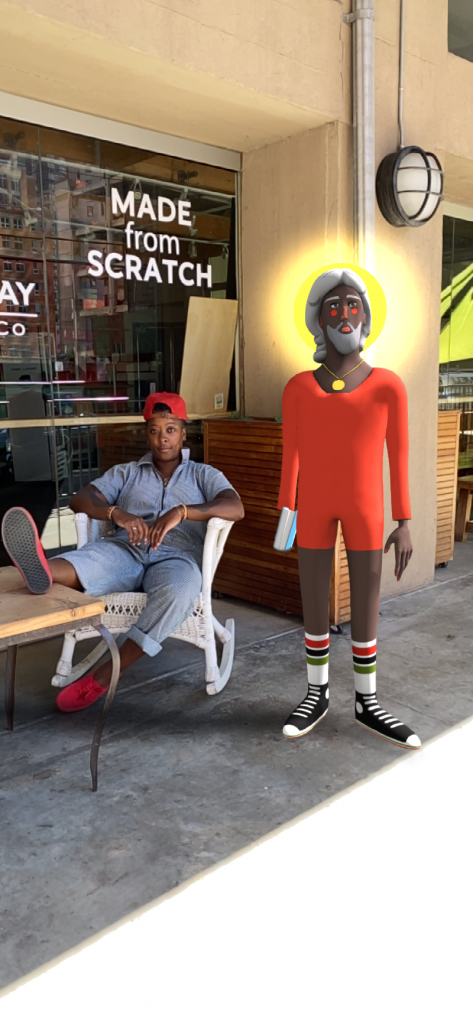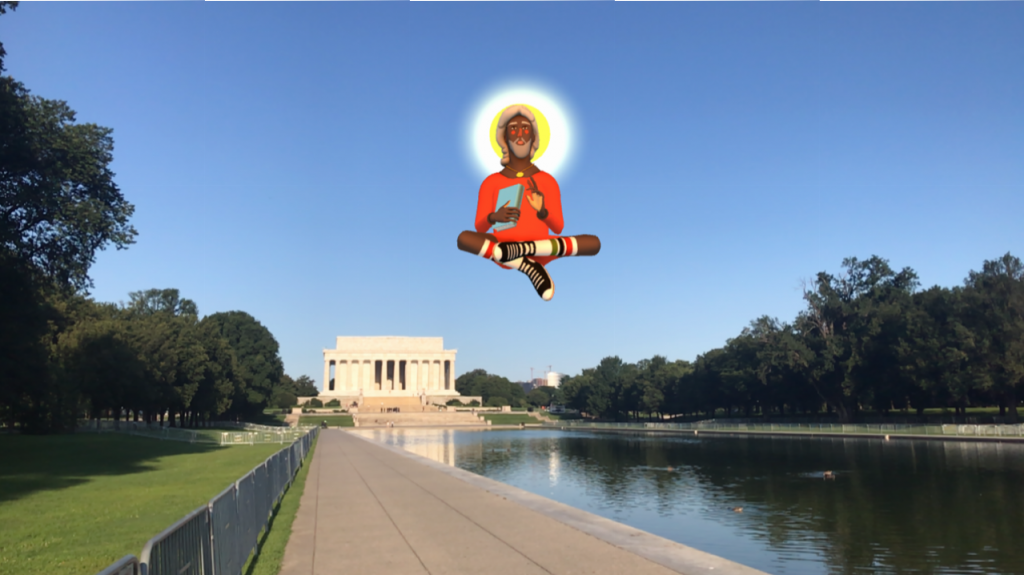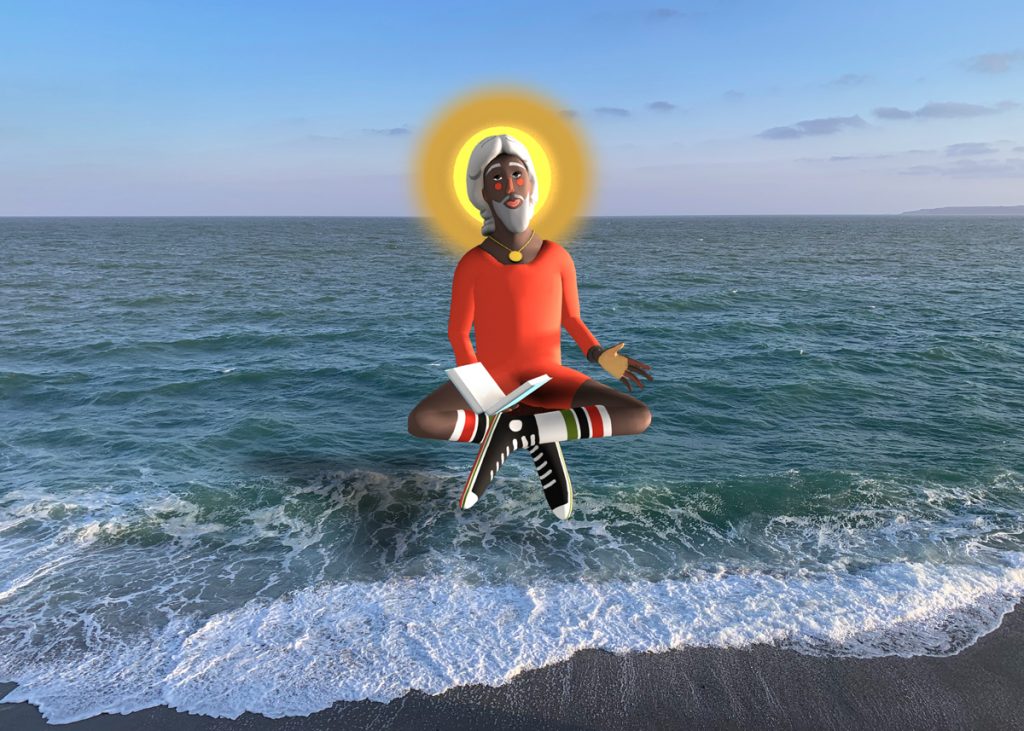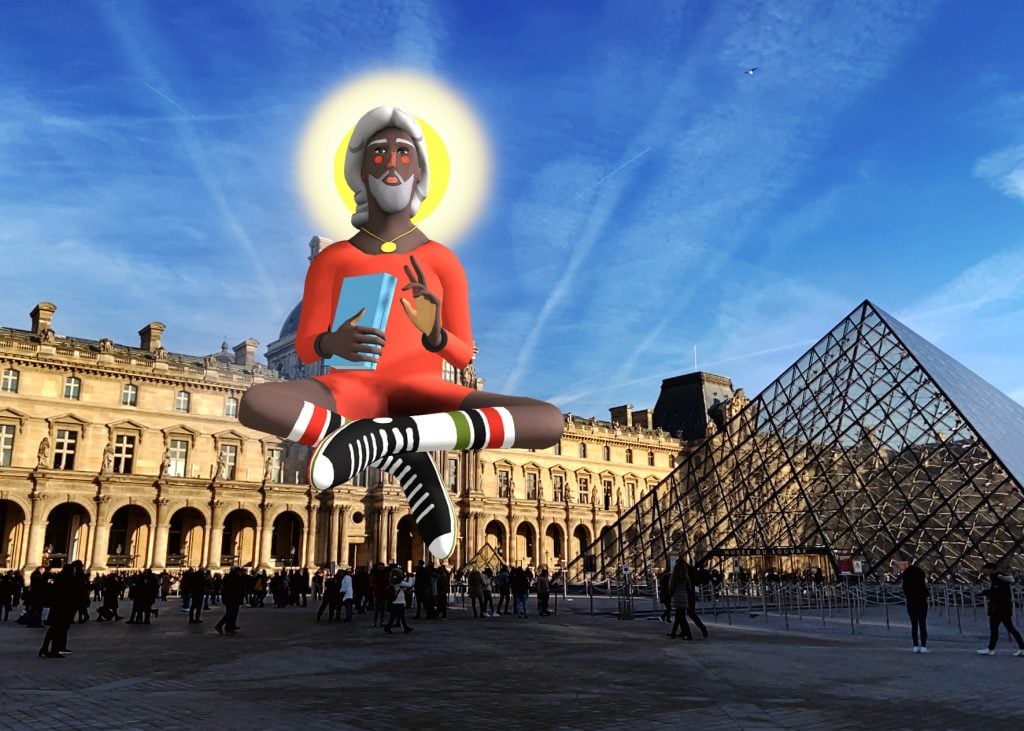People
‘I’m Offering It to Anyone Who’s Suffering’: Nina Chanel Abney on How Her First AR Artwork Is a Talisman for Those in Need of Hope
The artist's latest project will be unveiled to mark the 57th anniversary of the March on Washington.

The artist's latest project will be unveiled to mark the 57th anniversary of the March on Washington.

Naomi Rea

The artist Nina Chanel Abney has created her first augmented reality artwork.
Titled Imaginary Friend, the interactive artwork is being unveiled today, August 28, to mark the 57th anniversary of the March on Washington for Jobs and Freedom, which drew out at least 200,000 demonstrators and was highlighted by Martin Luther King, Jr.’s “I Have a Dream” speech.
The New York-based artist, who is known for her chaotic paintings that offer up a slice of contemporary life, often overlaps references to art history, religion, and celebrity in her work, and explores topics such as race and politics. The pictures can be a lot to take in all at once, and the AR work provides somewhat of an antidote to the frenetic scenes we are used to from Abney.

Nina Chanel Abney, Imaginary Friend in Washington, DC (2020). Courtesy Nina Chanel Abney and Acute Art. Photo by Leigh Vogel.
Created for the Acute Art app, the AR work takes the form of an interactive modern-day sage who is meant to help empower people to change situations. With voices, script, and music created in collaboration with Chris Chalk, Jeanette E. Toomer (Jet), and El Tsid—artists who “understand the value of humor in processing grief, trauma, and distress,” Abney says—the companion offers up blessings and advice.
Visible through the Acute Art app on smartphones, the work debuts today at the Lincoln Memorial, where King gave his speech, and where Black Lives Matter demonstrators are marching today.
The work is also being sited at other locations across the US (New York, Los Angeles, Chicago, and the Grand Canyon) and in cities around the world (Paris, London, Berlin, and Tokyo). A smaller version of Imaginary Friend will also be available for people using the app at home.
We spoke with the artist about the possibilities offered by technology, finding inspiration during lockdown, and the work as an offering to people in suffering.

Nina Chanel Abney, Imaginary Friend (2020). Courtesy: Nina Chanel Abney and Acute Art.
You’re unveiling this work on the 57th anniversary of the March on Washington, and it will be “installed” at the Lincoln Memorial among other places. What message do you hope the work carries?
The public work doesn’t necessarily carry a message; it’s more of an offering, like a protective talisman or even a good luck charm. I’m offering it to anyone who’s suffering right now. I’m offering it those who have lost their jobs due to the pandemic. I’m offering it to those who have lost their loved ones due to the pandemic. I’m offering it to the families and friends of people murdered by police and hateful individuals. I’m offering it to the protestors risking their lives to be on the streets right now in support of Black life. I’m offering it to the Earth, which is obviously in need of great healing right now.
And the animated version is an offering, but also a prompt to inspire us to reflect on this moment and ask ourselves, what can we do to change things for the better?
Was the project something you worked on during lockdown?
When lockdown first started, it was hard for me to feel creative. All my energy was going toward processing everything that was happening. But when I got back into the flow of things, I found I was able to be more imaginative in the absence of constant movement. In fact, I felt like I was tapping into an imaginative capacity that I haven’t used since childhood, back when you were sometimes forced to be innovative to have fun. Being an adult means work, travel, and day-to-day distractions. COVID and quarantine put an abrupt end to all of that in a serious way—but because of how I tend to process trauma, especially through my art, it didn’t necessarily inspire a serious or somber response.
A lot of people are experiencing this moment as a crisis, and in ways it definitely is, especially for people who are losing their health, their financial security, and their loved ones. But we’re also seeing an amplification of already-existing traumas in the US: of the pandemic affecting different populations differently, of the police showing that they are not here to serve and protect Black people, of billionaires making record profits while lines at food banks are longer than ever.
In my art, I usually approach whatever theme with an ambivalence—there is a purposeful flatness to my characters and the landscapes in order to allow for multiple interpretations. With this new project, this ambivalence is still at play, but the character now has a voice, a cadence, and a presence (even if it’s ghostly or virtual). So, in ways, this new project is a departure from my usual practice, and reflects this wild new locked-down world we live in. But it’s also a continuation of the same, both in terms of how I use caricature, ambivalence, and absurdity to process grief, and in terms of this crisis being an amplification of the traumas that people have been experiencing in day-to-day life and on screens for decades.

Nina Chanel Abney, Imaginary Friend in Paris, 2020, augmented reality. Courtesy: Nina Chanel Abney and Acute Art.
How did you find working with AR changed or opened up your practice?
This AR project gave me the opportunity to collaborate with other creatives in ways that I hadn’t before in my paintings. It pushed me to think about representation in different ways and brought new dimensions of figuration to my attention. Basically, this project involved bringing a character to life, one who talks and has a voice. For example, working with Chris and Jet—who are, respectively, coming from the world of acting and writing—I had to think about who this person is, who they are talking to, and figure out their whole vibe. But I didn’t want to make this a didactic character, one with a specific message for their “followers.” Instead, this “imaginary friend” sits quietly like a sage or guardian, or offers a parable for amusement and to prompt reflection.
The works will be viewable around the world but can also be seen by people at home. How does it feel to relinquish control over the context in which your work is shown and interacted with?
I’m genuinely excited about this, to move beyond the setting of a gallery and museum and the ways that people allow these settings to limit how they interpret the art—it makes that horizon of interpretation wider. I think people feel more comfortable interacting with and experiencing art when they’re in their own home. The art is truly yours in that context. And I think this takes my practice to another level—creating something that a viewer can put in a new context and that can be interacted with to prompt new meanings. I’ve never been one to feel overly protective or defensive with how people interpret or make meaning of my art, so the promiscuity that comes with relinquishing control over the context in which my art is experienced is something that is actually very appealing to me.